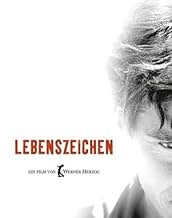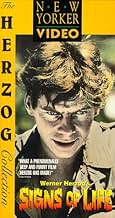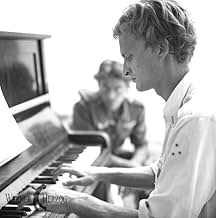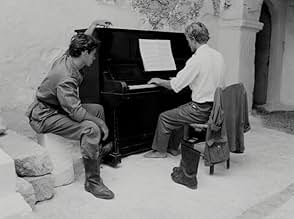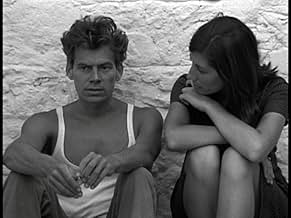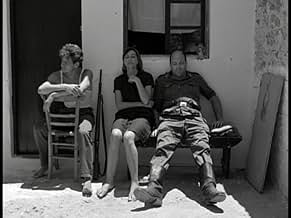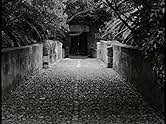ÉVALUATION IMDb
7,0/10
2,6 k
MA NOTE
Un parachutiste allemand blessé est envoyé sur l'île tranquille de Kos avec sa femme, une infirmière grecque et d'autres soldats qui se remettent de leurs blessures. Ils gardent un dépôt de ... Tout lireUn parachutiste allemand blessé est envoyé sur l'île tranquille de Kos avec sa femme, une infirmière grecque et d'autres soldats qui se remettent de leurs blessures. Ils gardent un dépôt de munitions dans une forteresse en ruine.Un parachutiste allemand blessé est envoyé sur l'île tranquille de Kos avec sa femme, une infirmière grecque et d'autres soldats qui se remettent de leurs blessures. Ils gardent un dépôt de munitions dans une forteresse en ruine.
- Director
- Writers
- Stars
- Prix
- 2 victoires et 2 nominations au total
Avis en vedette
I guess it should come as no surprise that there are no more than 8 reviews on IMDb about this film. The comfortably habitual Hollywood formula, which in so many ways as found itself in far more than Hollywood pictures, makes it hard for people to appreciate works such as this. This movie premiers Herzog's love for pictures and his rare ability to search them in the most mundane environments-a picture of a statue's foot embedded in the wall, a car slowly crossing a dancing road over a hill disappearing and appearing, two grown man entertained by the mysterious motion of the ears of a small owl toy figure...the list goes on forever.
It tells the story of a soldier who, after being wounded, is sent to recover in a small and peaceful Greek island where he and 3 others are ordered to care for a fort. That reveals itself a boring job and as time passes, the mundane days start slowly removing the sanity from the soldier. The story of a soldier gone mad is hardly novelty, but in Lebenszeichen the soldier goes mad from boredom and the location seems to be the cause of that and that's why we are shown the quiet little island. And it seems Herzog wants us in quiet observance of this routine, just so that he can slap us awake by the impending insanity of the character. My favorite scene is when we observe a landscape of windmills, which is usually used to portray a sense of quietude and peace, and over the hill, on the background of the picture, in small size, we see the soldier losing his mind, waving around like a madmen as if he was being tortured. That duality seems to display the despair in a higher note.
This is not an easy movie to understand and interpret, because it hides more than it shows, it indicates more than it reveals, it searches as much as it offers. Its a beautiful movie and while its not as great as some of Herzog's best efforts, it is certainly worthwhile and memorable.
PS: another reviewer seems to offer the idea that the movie might have been influenced the Stephen King's "The Shinning", but the film predates that novel by 9 years.
It tells the story of a soldier who, after being wounded, is sent to recover in a small and peaceful Greek island where he and 3 others are ordered to care for a fort. That reveals itself a boring job and as time passes, the mundane days start slowly removing the sanity from the soldier. The story of a soldier gone mad is hardly novelty, but in Lebenszeichen the soldier goes mad from boredom and the location seems to be the cause of that and that's why we are shown the quiet little island. And it seems Herzog wants us in quiet observance of this routine, just so that he can slap us awake by the impending insanity of the character. My favorite scene is when we observe a landscape of windmills, which is usually used to portray a sense of quietude and peace, and over the hill, on the background of the picture, in small size, we see the soldier losing his mind, waving around like a madmen as if he was being tortured. That duality seems to display the despair in a higher note.
This is not an easy movie to understand and interpret, because it hides more than it shows, it indicates more than it reveals, it searches as much as it offers. Its a beautiful movie and while its not as great as some of Herzog's best efforts, it is certainly worthwhile and memorable.
PS: another reviewer seems to offer the idea that the movie might have been influenced the Stephen King's "The Shinning", but the film predates that novel by 9 years.
Werner Herzog's debut feature tells the story of a wounded German paratrooper Stroszek (Peter Brogle) who is transported to the Greek island of Kos to recover physically and mentally. Already there are fellow soldiers Meinhard (Wolfgang Reichmann) and Becker (Wolfgang Von Ungern-Sterngberg), who are taking life easy in the sun with little to nothing to do. Stroszek sets them to work, but soon, as the work begins to dry up, he becomes more and more unstable in the isolation and loneliness.
Nobody really knows what goes through Herzog's head, but it is clear he is a film-making genius and has one of the finest eyes for visuals in cinema. Signs of Life explores themes that Herzog would later become engrossed and almost obsessed with - isolation, obsession and madness. While he would later employ Klaus Kinski as the face of wide-eyed insanity, here the tone is quiet, contemplative and often very funny. The opening half of the film concentrates mainly on the three soldiers trying to find things to do. Meinhard becomes frustrated with the presence of cockroaches in their apartment and builds a trap to catch them. The feeling of being trapped appears throughout the film, usually using animals - the soldiers are given a strange toy that seems to move on its own, until they open it and find out that it's full of trapped flies; and we are shown how a hen is hypnotised.
But the comedy is soon put aside as Stroszek begins his descent into madness, holding himself up in the 14th century fortress where the soldiers are stationed with a horde of ammunition. It's in the second half that Herzog shows us the images he can conjure. It's breathtaking what he achieves with a stolen 35mm camera and a micro-budget. Amongst other things, we see a seemingly endless field of windmills, and fireworks set off into the night sky. The grainy black-and-white imagery gives the whole thing a fresh beauty. This is far from the greatest debut in cinema, but a very clear indication of a director's raw skill, and of course, Herzog would go on to make many fine films.
www.the-wrath-of-blog.blogspot.com
Nobody really knows what goes through Herzog's head, but it is clear he is a film-making genius and has one of the finest eyes for visuals in cinema. Signs of Life explores themes that Herzog would later become engrossed and almost obsessed with - isolation, obsession and madness. While he would later employ Klaus Kinski as the face of wide-eyed insanity, here the tone is quiet, contemplative and often very funny. The opening half of the film concentrates mainly on the three soldiers trying to find things to do. Meinhard becomes frustrated with the presence of cockroaches in their apartment and builds a trap to catch them. The feeling of being trapped appears throughout the film, usually using animals - the soldiers are given a strange toy that seems to move on its own, until they open it and find out that it's full of trapped flies; and we are shown how a hen is hypnotised.
But the comedy is soon put aside as Stroszek begins his descent into madness, holding himself up in the 14th century fortress where the soldiers are stationed with a horde of ammunition. It's in the second half that Herzog shows us the images he can conjure. It's breathtaking what he achieves with a stolen 35mm camera and a micro-budget. Amongst other things, we see a seemingly endless field of windmills, and fireworks set off into the night sky. The grainy black-and-white imagery gives the whole thing a fresh beauty. This is far from the greatest debut in cinema, but a very clear indication of a director's raw skill, and of course, Herzog would go on to make many fine films.
www.the-wrath-of-blog.blogspot.com
Acknowledged as the film that inspired Stephen King's novel, The Shining, Signs of Life is a film which touches upon the rationality of insanity in a world gone mad. Set during the German occupation of Crete during World War II, the story centers around a German paratrooper (Stroszek played by Peter Brogle) who was injured during his first mission and sent to oversee an old fort in the uneventful city of Kos. Accompanied by his young Greek wife Nora (Athina Zacharopoulou), and two other German soldiers who do not fit well within the German military model (Wolfgang Reichmann as Meinhard and Wolfgang von Ungern-Sternberg as Becker), Stroszek is plagued by boredom and his own apparent uselessness. However, his young wife dutifully occupies her time learning German and taking care of domestic duties for the three men, Meinhard uses his engineering and creative skills to devise, among other things, a cockroach trap, and Becker studies Greek classical inscriptions and architecture, with which the fort is replete. Stroszek's only escape for the boredom of life at the fort is making Roman candles with Nora.
Typical for Herzog, Signs of Life portrays this boredom very effectively through content, pace and script, but without consigning its audience to the same fate. As with the equally excellent Heart of Glass, the passage of time seems at once extenuated and ambiguous in Signs of Life.
Stroszek becomes edgy, obsessive and unpredictable. Eventually he complains to his superiors that he has nothing to do and he is placed on a countryside patrol which is just as useless as sitting around at the fort. Surveying a beautiful countryside densely populated with a sea of windmills from a high vantage point, Stroszek finally snaps. He chases his wife and fellow soldiers out of the fort with a shotgun (though he clearly does not want to kill any of them) and begins an ominous stand-off with the occupation forces.
Herzog's frequent themes are mostly present in Signs of Life and are remarkably mature in this first major work of the master director. Stroszek is a familiar Herzog character - a man at war with society, reality and, ultimately, himself. Although it is fairly easy to write him off as a lunatic, Stroszek's part is written and acted well enough to permit a great deal of empathy. In later films dealing with similar characters and plots (i.e. Aguire: Wrath of God and Grizzly Man, etc) Herzog would take on less sympathetic crazies and examine them just as sensitively and even more powerfully. As in many of the great director's films, Herzog's anti-hero protagonist is as much a malignant product of social circumstance as a mirror of the insane implications of their own social context taken to extremes.
In Signs of Life, this is accomplished by an amazingly subtle treatment of the insanity of the German role in World War II and Stroszek's context as both a soldier and collateral casualty of that context. Subtle - because neither of these issues are examined at any point in the film, but rather - they permeate the entire film and provide the canvass for the story Herzog paints.
Herzog wrote and directed the film at the age of 25, with a paltry budget and a hand-held 35mm camera, setting sail on what has, so far, been one of the most interesting and productive career voyages in film. As usual, the sets are perfectly chosen and along with the cinematography, make the film a visual masterpiece. The script and acting are also exceptional, and though Signs of Life requires a good attention span, it does not fail to engage and entertain at many levels simultaneously.
Typical for Herzog, Signs of Life portrays this boredom very effectively through content, pace and script, but without consigning its audience to the same fate. As with the equally excellent Heart of Glass, the passage of time seems at once extenuated and ambiguous in Signs of Life.
Stroszek becomes edgy, obsessive and unpredictable. Eventually he complains to his superiors that he has nothing to do and he is placed on a countryside patrol which is just as useless as sitting around at the fort. Surveying a beautiful countryside densely populated with a sea of windmills from a high vantage point, Stroszek finally snaps. He chases his wife and fellow soldiers out of the fort with a shotgun (though he clearly does not want to kill any of them) and begins an ominous stand-off with the occupation forces.
Herzog's frequent themes are mostly present in Signs of Life and are remarkably mature in this first major work of the master director. Stroszek is a familiar Herzog character - a man at war with society, reality and, ultimately, himself. Although it is fairly easy to write him off as a lunatic, Stroszek's part is written and acted well enough to permit a great deal of empathy. In later films dealing with similar characters and plots (i.e. Aguire: Wrath of God and Grizzly Man, etc) Herzog would take on less sympathetic crazies and examine them just as sensitively and even more powerfully. As in many of the great director's films, Herzog's anti-hero protagonist is as much a malignant product of social circumstance as a mirror of the insane implications of their own social context taken to extremes.
In Signs of Life, this is accomplished by an amazingly subtle treatment of the insanity of the German role in World War II and Stroszek's context as both a soldier and collateral casualty of that context. Subtle - because neither of these issues are examined at any point in the film, but rather - they permeate the entire film and provide the canvass for the story Herzog paints.
Herzog wrote and directed the film at the age of 25, with a paltry budget and a hand-held 35mm camera, setting sail on what has, so far, been one of the most interesting and productive career voyages in film. As usual, the sets are perfectly chosen and along with the cinematography, make the film a visual masterpiece. The script and acting are also exceptional, and though Signs of Life requires a good attention span, it does not fail to engage and entertain at many levels simultaneously.
into a strange culture, in this case WW II German soldiers occupying a Greek island, three of them recuperating in an ancient fortress while a Nazi garrison is billeted in the town below. Herzog captures the exotic setting with brilliant photography, and at the same time the strangeness not only of culture clash but ultimately of the war itself. Intense Greek music on the soundtrack and the crystalline sunlight bring a sharp focus on the madness that comes to inhabit Stroszek's mind, the madness of seeing through what has been done in the name of the fatherland. Herzog's first major film is as much political meditation as it is psychological travelogue.
Werner Herzog's first film is a view into the mindset of the soldier who goes over the brink, but unlike many films that might explore the concept, or even Herzog's own later, arguably greater, Woyzeck, Signs of Life is about a man engulfed by the location. The setting is interesting right away; a stone fortress that men who have been wounded or just put on leave are guarding on a remote Greek island during WW2 (of course, we're never told this, which is appropriate, one can take a guess as to the significance of Herzog's POV as part of the New German cinema), and aside from the cockroaches and painting doors, there's not much to do. The mundane becomes engulfing, even as there's little things to do on the island. It's always bubbling under the surface, and as the days pass and things start to grow more aimless, Stroszek (Peter Brogle, with the kind of eyes and demeanor Kubrick would've loved to film) distances himself, sets of fireworks in his hands, and snaps one day out on patrol.
If anyone knows Herzog, the tale of a man going "berserk", as one officer says in this film of the main character, this shouldn't be seen out of the ordinary. Herzog has always tried to explore not so much of the precise 'whys' of the snap, or the break under pressure, or society's role or those around in personal quarters. Of course it's suggested a lot of the time, but in the case of Signs of Life we see much of the insanity in very long shots, with Stroszek going mad in the last twenty minutes on top of the fortress, wavering around, surrounded still by the immense landscape - an "inner" landscape, mayhap, as Herzog describes so often of his perspective on landscapes - of the fortress set against the background of the sea and mountains. But if one were seeing this as the first feature of some 26 year old Bavarian who only made a few shorts (one of which was similar somewhat to Signs of Life), this would seem like the most unclassifiable "genre" film ever made.
It's a movie about soldiers who don't fight, and with images like cut aways to peasants running and rummaging in the streets, a bird, a bunch of statues, stone tablets. And then when Stroszek does snap, we don't hear any audio, just the intense plucking of the guitar by the Greek composer, as Herzog pans over a whole field of windmills. And where else would one ever see something like when the bald soldier is setting up the trap for the roaches? Or the segway with the guy who thinks that he's a King? The first half of the movie is unsettling because it doesn't seem like it's going anywhere, and yet I kept on wanting to stay with Herzog (not even because I knew where it was going); there's something underneath all of the ho-hum "non" drama that goes on, little bits of behavior in the lackadaisical, that when finally things pick up dramatically it starts slowly, then builds, goes to a peak, and then...
Well, you'll just have to see for yourself. All I know is that you're likely not to see another film like Signs of Life- much less a debut from a major European film artist- where the climax entails fireworks going off while practical martial law is placed over the island. Herzog doesn't follow any rules, and it can get frustrating here and there. But it's also exhilarating, and I would probably count it in my top 10 favorites of the director.
If anyone knows Herzog, the tale of a man going "berserk", as one officer says in this film of the main character, this shouldn't be seen out of the ordinary. Herzog has always tried to explore not so much of the precise 'whys' of the snap, or the break under pressure, or society's role or those around in personal quarters. Of course it's suggested a lot of the time, but in the case of Signs of Life we see much of the insanity in very long shots, with Stroszek going mad in the last twenty minutes on top of the fortress, wavering around, surrounded still by the immense landscape - an "inner" landscape, mayhap, as Herzog describes so often of his perspective on landscapes - of the fortress set against the background of the sea and mountains. But if one were seeing this as the first feature of some 26 year old Bavarian who only made a few shorts (one of which was similar somewhat to Signs of Life), this would seem like the most unclassifiable "genre" film ever made.
It's a movie about soldiers who don't fight, and with images like cut aways to peasants running and rummaging in the streets, a bird, a bunch of statues, stone tablets. And then when Stroszek does snap, we don't hear any audio, just the intense plucking of the guitar by the Greek composer, as Herzog pans over a whole field of windmills. And where else would one ever see something like when the bald soldier is setting up the trap for the roaches? Or the segway with the guy who thinks that he's a King? The first half of the movie is unsettling because it doesn't seem like it's going anywhere, and yet I kept on wanting to stay with Herzog (not even because I knew where it was going); there's something underneath all of the ho-hum "non" drama that goes on, little bits of behavior in the lackadaisical, that when finally things pick up dramatically it starts slowly, then builds, goes to a peak, and then...
Well, you'll just have to see for yourself. All I know is that you're likely not to see another film like Signs of Life- much less a debut from a major European film artist- where the climax entails fireworks going off while practical martial law is placed over the island. Herzog doesn't follow any rules, and it can get frustrating here and there. But it's also exhilarating, and I would probably count it in my top 10 favorites of the director.
Le saviez-vous
- AnecdotesWerner Herzog's first feature film. Often regarded as a pioneer of New German Cinema, his films often feature ambitious protagonists with impossible dreams, people with unusual talents in obscure fields, or individuals in conflict with nature. In 1961, when Herzog was 19, he started work on his first film Herakles. He has since produced, written, and directed over 60 films and documentaries. He has also published over 12 books of prose and directed many operas. French filmmaker François Truffaut once called Herzog "the most important film director alive." American film critic Roger Ebert said that Herzog "has never created a single film that is compromised, shameful, made for pragmatic reasons, or uninteresting. Even his failures are spectacular." He was named one of the world's 100 most influential people by Time in 2009.
- Citations
Young Child: Now that I can talk, what shall I say?
- ConnexionsFeatured in Was ich bin, sind meine Filme (1978)
Meilleurs choix
Connectez-vous pour évaluer et surveiller les recommandations personnalisées
- How long is Signs of Life?Propulsé par Alexa
Détails
Box-office
- Budget
- 25 000 DEM (estimation)
- Durée1 heure 30 minutes
- Couleur
- Mixage
- Rapport de forme
- 1.37 : 1
Contribuer à cette page
Suggérer une modification ou ajouter du contenu manquant

Lacune principale
By what name was Lebenszeichen (1968) officially released in India in English?
Répondre
